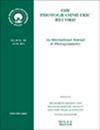民用工程战时侦察航拍及相关材料的应用
IF 3.6
3区 地球科学
Q2 GEOGRAPHY, PHYSICAL
引用次数: 3
摘要
在第一次世界大战和第二次世界大战期间,为军事侦察目的而获取和解释航空照片花费了大量精力。起初,这些材料是保密的;然而,随着时间的推移,现在很多已经解密,并向公众开放。有各种各样的信息可以用于许多学科。本材料包括摄影印刷品,解释手册,解释报告,目标计划,和相机,镜头和安装的技术细节。将以联合王国、法国和意大利的例子来说明这种材料的使用,主要用于土木工程现场研究。我们将讨论这些材料的各种来源。复本:第一阶段和第二阶段的世界大战,在一次部署中,我们的努力是,我们的任务是解释航空摄影和军事侦察的结果。在机密文件上首次亮相;主要的维护者,le temps etant ecoule,甚至是一个解密的大型派对,而不是向大型公众开放。在一个简单的例子中,作者整理了大量的信息,这些信息是非常重要的。这些文件的内容包括:摄影的内容、解释的内容、解释的内容、物体(军事)的内容、细节技术的内容、摄影的内容、物体的内容。Ľ internet du recours and ces文档est illustre par des examples provant du Royaume-Uni, de France and ďItalie, essentielement dans le domaindu genie civil pour des stududes de sites。在审查平等的情况下,不同来源的文件。zusamenfassung Wahrend 1。和2。对军事主义思想的理解与解释。Anfanglich wurde dieses Material under verschlub gehalten, im Laufe der Zeitjedoch wurde vielesfreigegeben and ist nun der Offentlichkeit zuganglich。他给了我一个信息,我给了你一个信息,我给了你一个信息。《材料》、《解释手册》、《解释手册》、《平面》和《技术细节》、《相机》、《目标》和《Aufhangungen》。在德国,在德国,在意大利,在德国,在德国,在德国,在德国,在德国,在德国,在德国,在德国,在德国,在德国,在德国,在德国,在德国,在德国。Die vielfaltigen Quellen for dieses材料被称为diskutische。本文章由计算机程序翻译,如有差异,请以英文原文为准。
Civil engineering applications of wartime reconnaissance aerial photography and related material
During both the First and Second World Wars, much effort was put into obtaining and interpreting aerial photographs for military reconnaissance purposes. Initially this material was classified; however, with the passing of time, much has now been declassified and is accessible to the general public. There is a large variety of information which can be of use to a number of disciplines. This material includes photographic prints, interpretation manuals, interpretation reports, plans of targets, and technical details of cameras, lenses and mountings. The use of this material will be demonstrated with examples from the United Kingdom, France and Italy, primarily for civil engineering site studies. The varied sources of this material will be discussed.
Resume
Au cours de la premiere et de la seconde Guerre Mondiale, on a deploye beaucoup ď efforts dans le receuil et ľ interpretation de photographies aeriennes a des fins de reconnaissance militaire. Au debut on classifia ces documents; mais maintenant, le temps etant ecoule, on en a declassifie une grande partie pour la rendre accessible au grand public. On peut ainsi y trouver toutes sortes ď informations qui peuvent etre utiles a de nombreuses disciplines. Ces documents comprennent des tirages photographiques, des manuels ď interpretation, des rapports ď interpretation, des plans ď objectifs (militaires), et des details techniques sur les chambres photographiques, leurs objectifs et leurs montures. Ľ interet du recours a ces documents est illustre par des examples provenant du Royaume-Uni, de France et ďItalie, essentiellement dans le domaine du genie civil pour des etudes de sites. On examine egalement les diverses origines de ces documents.
Zusammenfassung
Wahrend des 1. und 2. Weltkrieges wurde vielAufwand zur Gewinnung und Interpretation von Luftbildern fur militarische Erkundungszwecke geleistet. Anfanglich wurde dieses Material unter Verschluβ gehalten, im Laufe der Zeitjedoch wurde vielesfreigegeben und ist nun der Offentlichkeit zuganglich. Es gibt eine Vielzahl von Informationen, die fur eine Anzahl von Disziplinen von Nutzen sein kann. Das Material umfaβt Fotokopien, Interpretationsmanuale, Interpretationsberichte, Plane von Zielen und technische Details uber Kameras, Objektive und Aufhangungen. Die Nutzung dieses Materials wirdan Hand von Beispielen aus dem Vereinigten Konigreich, aus Frankreich und aus Italien gezeigt, und zwar vor allem fur Analysen von Baustellen. Die vielfaltigen Quellen fur dieses Material werden diskutiert.
求助全文
通过发布文献求助,成功后即可免费获取论文全文。
去求助
来源期刊

Photogrammetric Record
地学-成像科学与照相技术
CiteScore
3.60
自引率
25.00%
发文量
71
审稿时长
>12 weeks
期刊介绍:
The Photogrammetric Record is an international journal containing original, independently and rapidly refereed articles that reflect modern advancements in photogrammetry, 3D imaging, computer vision, and other related non-contact fields. All aspects of the measurement workflow are relevant, from sensor characterisation and modelling, data acquisition, processing algorithms and product generation, to novel applications. The journal provides a record of new research which will contribute both to the advancement of photogrammetric knowledge and to the application of techniques in novel ways. It also seeks to stimulate debate though correspondence, and carries reviews of recent literature from the wider geomatics discipline.
Relevant topics include, but are not restricted to:
- Photogrammetric sensor calibration and characterisation
- Laser scanning (lidar)
- Image and 3D sensor technology (e.g. range cameras, natural user interface systems)
- Photogrammetric aspects of image processing (e.g. radiometric methods, feature extraction, image matching and scene classification)
- Mobile mapping and unmanned vehicular systems (UVS; UAVs)
- Registration and orientation
- Data fusion and integration of 3D and 2D datasets
- Point cloud processing
- 3D modelling and reconstruction
- Algorithms and novel software
- Visualisation and virtual reality
- Terrain/object modelling and photogrammetric product generation
- Geometric sensor models
- Databases and structures for imaging and 3D modelling
- Standards and best practice for data acquisition and storage
- Change detection and monitoring, and sequence analysis
 求助内容:
求助内容: 应助结果提醒方式:
应助结果提醒方式:


